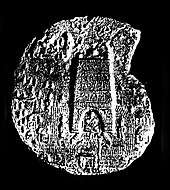Shikhara
Shikhara (IAST: Śikhara), a Sanskrit word translating literally to "mountain peak", refers to the rising tower in the Hindu temple architecture of North India, and also often used in Jain temples. A shikhara over the garbhagriha chamber where the presiding deity is enshrined is the most prominent and visible part of a Hindu temple of North India.[1][2]
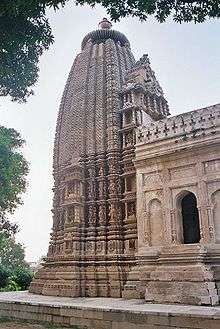

In South India, the equivalent term is vimana; unlike the shikhara, this refers to the whole building, including the sanctum beneath. In the south, shikhara is a term for the top stage of the vimana only, which is usually a dome capped with a finial;[3] this article is concerned with the northern form. The southern vimana is not to be confused with the elaborate gateway-towers of south Indian temples, called gopuram, which are often taller and more prominent features in large temples.
Forms
Shikhara can be classified into three main forms:[4]
- Latina. The shikhara has four faces, which may include projections or ratha within each face. All the elements run smoothly up the face in a curve. The most common.[5] They are also sometimes called "homogeneous" shikhara, as opposed to the next two types, which may be called "heterogeneous".[6]
- Sekhari. The latina shape has added engaged (attached) sub-spires or spirelets called urushringa echoing the main shape. These may run up most of the face. There may be more than one size of these, sometimes called secondary and tertiary. Tertiary spirelets are typically near the ends of the face or on the corners.[7]
- Bhumija. The tower has miniature spires, in horizontal and vertical rows, all the way to the top,[8] creating a grid-like effect on each face. The tower is generally less strongly vertical in overall shape, often approaching a pyramidal shape. Mainly found in the northern Deccan and West India.[7]
History
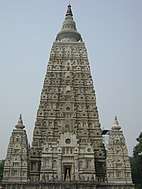
The early history of the Hindu shikhara is unclear,[10] but the Buddhist Mahabodhi Temple at Bodh Gaya has a straight-sided shikhara tower over 55 metres (180 feet) high, with an amalaka near the top. The current structure dates from the Gupta Empire, in the 5th–6th century CE. When the temple acquired its shikhara tower, today considered more characteristic of Hindu temples, is uncertain.[11]
However the current structure of the Mahabodhi Temple may represent a restoration of earlier work of the 2nd or 3rd century CE.[9] A plaque from Kumrahar dated 150-200 CE, based on its dated Kharoshthi inscriptions and combined finds of Huvishka coins, already shows the Mahabodhi Temple in its current shape with a stepped truncated pyramid and a stupa finial on top, together with devotional images of the Buddha and the elephant-crowned Pillar of Ashoka next to the entrance.[12] It is thought that this shape of a truncated pyramid was derived from the design of the stepped stupas which had developed in Gandhara, as seen in the stupas of Jaulian, with an elongated structure formed of a succession of steps with niches containing Buddha images, alternating with Greco-Roman pillars, and topped by a stupa.[9][13]
By at least 600 CE in Odisha,[14] and perhaps somewhat later in the Deccan Plateau and West India,[15] the Latina form of the shikhara is well-established, with an amalaka disk-stone at the top, and then a kalasha urn. There is often a sukanasa feature over the entrance door.[16]
The forms with smaller subsidiary spires begin in the 10th century,[17] and from then on tend to predominate. The Khajuraho Group of Monuments has several early forms from early in the century, though Latina ones reappear after about 1050, in examples like the Vamana Temple.[18] The bhumija spire probably first appears around 1000-1025, with other temples begun in the 1050s, such as the Shiv Mandir, Ambarnath.[19]
Major styles
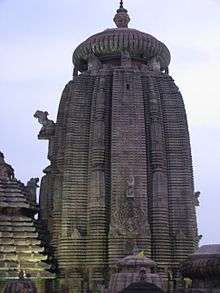
Shikharas form an element in the many styles of Hindu temple architecture, of which the three most common are:[1]
- the Nagara style prevalent in northern India. The shikhara is a high curved shape, and so called. In the north-east, the local term deul or deula is more often used, both for towers and often the whole temple. In Odisha a Rekha Deula is the sanctum and the tower over it; gandi is also a term for the upper tower only, equating to shikhara. In Odisha the curve is very slight until the top, and the amalaka rather large, typically supported by four lion sculptures facing out.[20] Of the many temples in Bhubaneswar, only the Rajarani Temple has significant spirelets.[21]
- the Vesara style, a synthesis of the two others, seen mostly in Karnataka and most commonly in Hoysala and later Chalukya temples. In the vesara style, the tower moves towards a lower conical shape, with highly ornate carving.
- the Dravidian style prevalent in southern India : The equivalent of the shikhara is the vimana. The superstructure above the sanctum is typically more like a four-sided pyramid in overall shape, consisting of progressively smaller storeys of pavilions (talas), with a profile that is normally straight rather than curved. The Dravidian superstructure is generally highly ornate.
In every style of shikhara/vimana, the structure culminates with a "kalasha", or urn for offerings, or water-pot, at its peak.
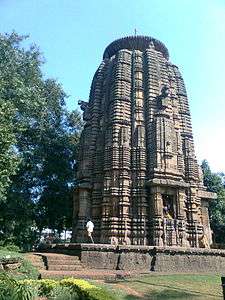 Nagara shikhara of Rameshwar Temple in Bhubaneswar
Nagara shikhara of Rameshwar Temple in Bhubaneswar- Dravidian vimana of Murudeshwara Temple
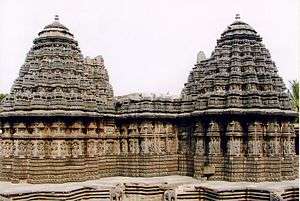 Vesara style of Chennakesava Temple, Somanathapura. Towers are in 16 pointed star plan.
Vesara style of Chennakesava Temple, Somanathapura. Towers are in 16 pointed star plan.
See also
| Wikimedia Commons has media related to Shikharas. |
Notes
- http://www.msc-sahc.org/upload/docs/new.docs/2008_SVardia.pdf
- "Shikhara". Encyclopædia Britannica. Retrieved 4 August 2015.
- Harle, 167
- Hardy, 270
- Hardy, 270-272
- Volwahsen, Andreas (1968). Inde bouddhique, hindoue, jaïn (Architecture universelle ed.). Fribourg (Suisse): Office du Livre. pp. 143–147.
- Hardy, 273-274
- "bhumija (Indian architecture)". Encyclopædia Britannica. Archived from the original on 11 November 2007. Retrieved 2007-12-30.
- Le Huu Phuoc, Buddhist Architecture, pp.238-248
- Harle, 111, 136-139
- Harle, 201; Michell, 228-229
- Buddhist Architecture, Le Huu Phuoc, Grafikol 2009, p.242
- Ching, Francis D. K.; Jarzombek, Mark M.; Prakash, Vikramaditya (2010). A Global History of Architecture. John Wiley & Sons. p. 231. ISBN 9781118007396.
- Harle, 158-159
- Harle, 136-139, 166-171
- Harle, 140
- Harle, 219
- Harle, 232-235
- Harle, 230-232
- Harle, 246
- Harle, 246, 249
References
- Hardy, Adam, Indian Temple Architecture: Form and Transformation : the Karṇāṭa Drāviḍa Tradition, 7th to 13th Centuries, 1995, Abhinav Publications, ISBN 8170173124, 9788170173120, google books
- Harle, J.C., The Art and Architecture of the Indian Subcontinent, 2nd edn. 1994, Yale University Press Pelican History of Art, ISBN 0300062176
- Michell, George (1988), The Hindu Temple: An Introduction to Its Meaning and Forms, University of Chicago Press, ISBN 978-0226532301
